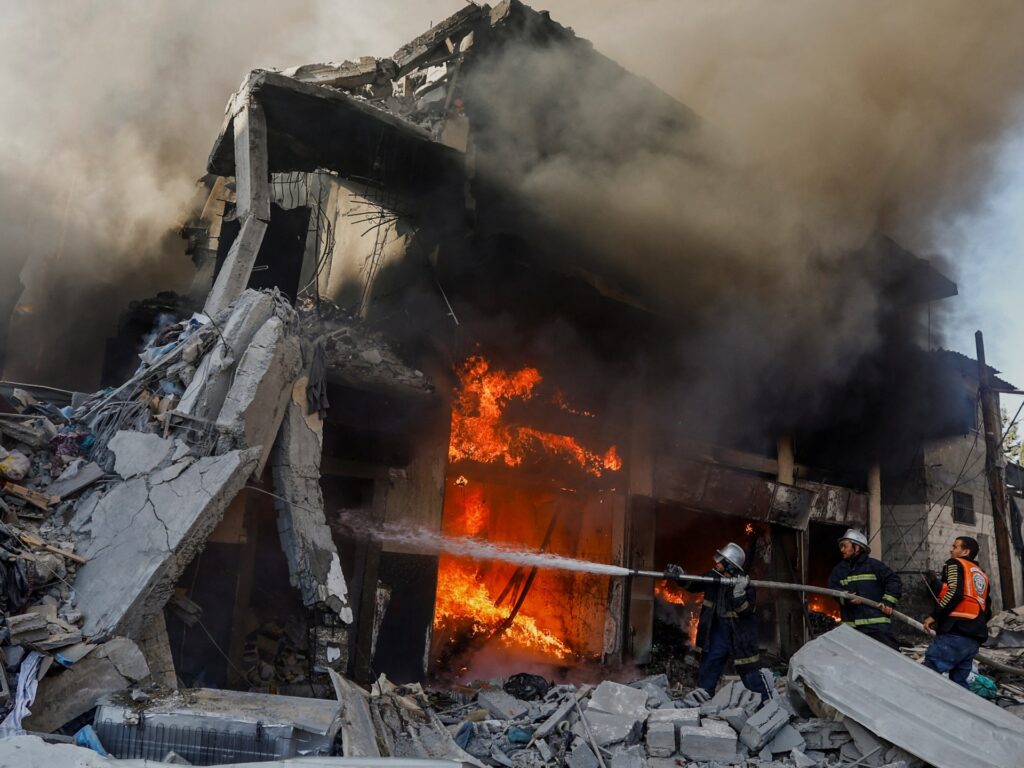In the week following the expiration of the “humanitarian pause,” Israel intensified its invasion of the Gaza Strip. Aerial bombardments by the Israeli Air Force (IAF) resumed within minutes of the difficult week-long break that ended on December 1. They were then followed by the advance of armored units, artillery and ground infantry.
During the truce, Israeli forces continued to issue warnings and threats aimed primarily at Hamas but also at the Palestinian population. Once the truce ended, Israel showed that it meant what it said, launching a strong and determined offensive towards the southern Gaza Strip, primarily targeting the town of Khan Younis.
Many analysts expected them to advance further toward the urban center of Gaza City, with the three columns that led the invasion along different axes converging toward the Old City.
Instead, Israeli forces decided to open a new front by advancing into the southern part of Gaza. In a manner similar to their assault on Gaza City in November, they again chose to encircle the city before taking the next step.
North of the town of Khan Younis, two columns of armor, artillery and mechanized infantry advanced towards western Israel, towards the sea. But rather than push to the shore, they stopped at two kilometers from the beaches and sent troops into each other on the Salah al-Din road, the main artery that runs along the entire Gaza Strip from north to south. When the Israeli battalions met halfway, they completed the encirclement of the Jarara area to the Israeli border.
It is not clear why Israel chose to keep significant forces engaged in blocking this small piece of territory, farmland and suburbs of seemingly insignificant defensive value, rather than attempting to seize it. not clear.
An additional column was then sent from Israel towards the center of Khan Younis from the east, while Israeli tanks and mechanized infantry appeared to advance slowly and simultaneously on the Salah al-Din road towards the urban center.
In preparation for the action in the southern part of Gaza, Israel published a map dividing the entire besieged territory into 623 blocks of varying sizes. He then began ordering Palestinians to evacuate the blocks where he would conduct military operations. Israel announced that this approach, “based on sophisticated mapping software,” aimed to protect civilians from military operations, in part to satisfy the United States’ demand to reduce civilian casualties.
Alas, it was just a public relations stunt. Israeli authorities are fully aware that the south is full of refugees from Gaza City and other areas evacuated either on direct orders from the occupiers or for fear of being caught in deadly fighting. Most of the nearly two million residents in this area of no more than 200 square kilometers live in makeshift conditions, with only intermittent electricity and little access to media or the internet. There is therefore little chance that they will be able to react in the short term. evacuation orders. Aerial bombardments continue unabated and civilian casualties remain high, with more than 17,000 people killed, including more than 7,000 children.
These figures are very disproportionate to the 93 Israelis killed so far in Gaza, all members of the army.
Global calls to stop the fighting in Gaza are growing and even the United States, despite its close relationship with Israel, is visibly beginning to feel uneasy. At the United Nations Security Council, he vetoed a call for a humanitarian ceasefire, but even with the United Kingdom, its traditional ally, abstaining and the remaining 13 members favoring an end war, Washington undoubtedly realizes that the demands to end the plight of civilians are only increasing.
Israel tries to repel accusations of indiscriminate killings of civilians, but its claims make little sense. Earlier this week, at a press briefing in Israel, an official said that one Hamas fighter was killed for every two civilians, suggesting that this was a better ratio of fighters to civilians killed than most. armies in recent wars.
Even putting cynicism aside, the calculations of this claim lead to skepticism. With nearly 17,400 deaths, this would imply that Hamas suffered 5,800 combat deaths, a ratio of more than 62 killed for every Israeli soldier lost in combat.
Even allowing for the hypothetical and highly unrealistic possibility that half of them were killed out of combat, in bed or on the street, this would still mean that the Israeli army killed 2,900 enemies while suffering only 93 casualties. in combat.
In military terms, the ratio of more than 31 enemy soldiers killed to one killed in action indicates a significant defeat, if not a rout. This is a militarily and psychologically untenable situation for the losing side.
Certainly, it can happen that a military formation loses 30 soldiers in a battle where only one enemy dies; usually this battle is lost, but not necessarily the war.
But for almost all armies, a consistent casualty rate of more than 30:1 in operations lasting more than a month on at least two separate battlefields, if connected – north and south Gaza – would be a sure sign of imminent total collapse. .
Even taking into account the high motivation of Hamas fighters recruited for ideological reasons, it would be difficult to imagine that they could continue fighting after such losses.
“I see signs that (Hamas) is starting to make inroads in Gaza,” Israeli Defense Minister Yoav Gallant told visiting troops Friday.
Gallant’s claim was either an exaggeration or an optimistic attempt to boost the morale of his soldiers. In reality, it is clear that Hamas continues to fight – in a way that would not be possible if it lost as many fighters as Israel claims to kill.

